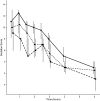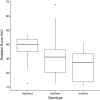The Effect of the Canine ABCB1-1Δ Mutation on Sedation after Intravenous Administration of Acepromazine
- PMID: 26822006
- PMCID: PMC4913601
- DOI: 10.1111/jvim.13827
The Effect of the Canine ABCB1-1Δ Mutation on Sedation after Intravenous Administration of Acepromazine
Abstract
Background: Dog breeds with the ABCB1-1Δ mutation have substantially truncated nonfunctional P-glycoprotein. Dogs homozygous for this mutation (mut/mut) are susceptible to the toxic adverse effects of ivermectin, loperamide, and vincristine. Anecdotal reports suggested ABCB1 mut/mut dogs showed increased depth and duration of acepromazine sedation.
Hypothesis/objectives: That ABCB1 mut/mut dogs have increased depth and duration of sedation after acepromazine IV compared to normal dogs (nor/nor).
Animals: Twenty-nine rough-coated collies were divided into 3 groups of dogs based on their ABCB1 genotype: 10 mut/mut, 10 mut/nor, and 9 nor/nor.
Methods: Dogs were given 0.04 mg/kg of acepromazine IV. Level of sedation, heart rate, respiratory rate, and blood pressure were recorded for 6 hours after acepromazine administration. Area under the curves (AUCs) of the normalized sedation score results were calculated and compared.
Results: The median sedation scores for ABCB1 mut/mut dogs were higher than nor/nor dogs at all time points and were higher in mut/nor dogs for the first 2 hours. These differences were not found to be significant for any individual time point (P > .05). The median sedation score AUC for mut/mut dogs was significantly higher than nor/nor dogs (P = .028), but the AUC for mut/nor dogs was not (P = .45). There were no significant differences between groups for heart rate, respiratory rate, and blood pressure (P > .05).
Conclusions and clinical importance: In ABCB1 mut/mut dogs acepromazine dose rates should be reduced and careful monitoring performed during sedation.
Keywords: Collie; MDR1; P-glycoprotein.
Copyright © 2016 The Authors. Journal of Veterinary Internal Medicine published by Wiley Periodicals, Inc. on behalf of the American College of Veterinary Internal Medicine.
Figures


Similar articles
-
Effects of acepromazine, hydromorphone, or an acepromazine-hydromorphone combination on the degree of sedation in clinically normal dogs.J Am Vet Med Assoc. 2010 Nov 15;237(10):1155-9. doi: 10.2460/javma.237.10.1155. J Am Vet Med Assoc. 2010. PMID: 21073386 Clinical Trial.
-
Effects of 3 morphine doses, in combination with acepromazine, on sedation and some physiological parameters in dogs.Can J Vet Res. 2019 Jul;83(3):235-240. Can J Vet Res. 2019. PMID: 31308597 Free PMC article.
-
Comparative study on the sedative effects of morphine, methadone, butorphanol or tramadol, in combination with acepromazine, in dogs.Vet Anaesth Analg. 2009 Jan;36(1):25-33. doi: 10.1111/j.1467-2995.2008.00424.x. Vet Anaesth Analg. 2009. PMID: 19121156 Clinical Trial.
-
Canine ABCB1 and macrocyclic lactones: heartworm prevention and pharmacogenetics.Vet Parasitol. 2008 Dec 10;158(3):215-22. doi: 10.1016/j.vetpar.2008.09.009. Epub 2008 Sep 7. Vet Parasitol. 2008. PMID: 18922637 Review.
-
Risk factors for anaesthetic-related death in referred dogs.Vet Rec. 2006 Apr 22;158(16):563-4. doi: 10.1136/vr.158.16.563. Vet Rec. 2006. PMID: 16632532 Review. No abstract available.
Cited by
-
The canine blood-brain barrier in health and disease: focus on brain protection.Vet Q. 2025 Dec;45(1):12-32. doi: 10.1080/01652176.2025.2450041. Epub 2025 Jan 10. Vet Q. 2025. PMID: 39791202 Free PMC article. Review.
-
A Bottom-up Approach for Mutant and Wild Type Collies Using Physiologically Based Pharmacokinetic (PBPK) Modeling: A Case Study Using Loperamide.AAPS J. 2025 Jun 2;27(4):101. doi: 10.1208/s12248-025-01061-6. AAPS J. 2025. PMID: 40457124
-
Tolerance and Pharmacokinetics of Galliprant™ Administered Orally to Collies Homozygous for MDR1-1Δ.J Vet Pharmacol Ther. 2021 Sep;44(5):705-713. doi: 10.1111/jvp.12984. Epub 2021 Jul 4. J Vet Pharmacol Ther. 2021. PMID: 34219249 Free PMC article.
-
Adverse Drug Reactions After Administration of Emodepside/Praziquantel (Profender®) in an MDR1-Mutant Australian Shepherd Dog: Case Report.Front Vet Sci. 2019 Sep 6;6:296. doi: 10.3389/fvets.2019.00296. eCollection 2019. Front Vet Sci. 2019. PMID: 31555677 Free PMC article.
-
Canine and feline P-glycoprotein deficiency: What we know and where we need to go.J Vet Pharmacol Ther. 2023 Jan;46(1):1-16. doi: 10.1111/jvp.13102. Epub 2022 Nov 3. J Vet Pharmacol Ther. 2023. PMID: 36326478 Free PMC article. Review.
References
-
- Martinez M, Modric S, Sharkey M, et al. The pharmacogenomics of P‐glycoprotein and its role in veterinary medicine. J Vet Pharmacol Ther 2008;31:285–300. - PubMed
-
- Mealey KL, Bentjen SA, Gay JM, et al. Ivermectin sensitivity in collies is associated with a deletion mutation of the mdr1 gene. Pharmacogenetics 2001;11:727–733. - PubMed
-
- Roulet A, Puel O, Gesta S, et al. MDR1‐deficient genotype in Collie dogs hypersensitive to the P‐glycoprotein substrate ivermectin. Eur J Pharmacol 2003;460:85–91. - PubMed
-
- Nelson OL, Carsten E, Bentjen SA, et al. Ivermectin toxicity in an Australian Shepherd dog with the MDR1 mutation associated with ivermectin sensitivity in Collies. J Vet Intern Med 2003;17:354–356. - PubMed
Publication types
MeSH terms
Substances
LinkOut - more resources
Full Text Sources
Other Literature Sources

